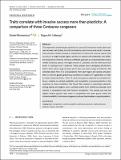Por favor, use este identificador para citar o enlazar a este item:
http://hdl.handle.net/10261/182680COMPARTIR / EXPORTAR:
 SHARE SHARE
 CORE
BASE CORE
BASE
|
|
| Visualizar otros formatos: MARC | Dublin Core | RDF | ORE | MODS | METS | DIDL | DATACITE | |

| Título: | Traits correlate with invasive success more than plasticity: A comparison of three Centaurea congeners |
Autor: | Montesinos, D. CSIC ORCID; Callaway, Ragan M. | Palabras clave: | Biogeography Competition Nutrient availability Phenotypic plasticity Relative distance Plasticity indexes Trait shifts |
Fecha de publicación: | ago-2018 | Editor: | John Wiley & Sons | Citación: | Ecology and Evolution 8(15): 7378-7385 (2018) | Resumen: | The importance of phenotypic plasticity for successful invasion by exotic plant species has been well studied, but with contradictory and inconclusive results. However, many previous studies focused on comparisons of native and invasive species that co‐occur in a single invaded region, and thus on species with potentially very different evolutionary histories. We took a different approach by comparing three closely related Centaurea species: the highly invasive C. solstitialis, and the noninvasive but exotic C. calcitrapa and C. sulphurea. These species have overlapping distributions both in their native range of Spain and in their non‐native range of California. We collected seeds from 3 to 10 populations from each region and species and grew them in common garden greenhouse conditions to obtain an F1 generation in order to reduce maternal effects. Then, F1 seeds were grown subjected to simulated herbivory, variation in nutrient availability, and competition, to explore plasticity in the responses to these conditions. We found little variation in phenotypic plasticity among species and regions, but C. solstitialis plants from California produced more biomass in competition than their Spanish conspecifics. This species also had the highest relative growth rates when in competition and when grown under low nutrient availability. Noninvasive congeners produced intermediate or opposite patterns. | Versión del editor: | http://dx.doi.org//10.1002/ece3.4080 | URI: | http://hdl.handle.net/10261/182680 | DOI: | 10.1002/ece3.4080 | ISSN: | 2045-7758 |
| Aparece en las colecciones: | (CIDE) Artículos |
Ficheros en este ítem:
| Fichero | Descripción | Tamaño | Formato | |
|---|---|---|---|---|
| Traits_correlate.pdf | 608,7 kB | Adobe PDF |  Visualizar/Abrir |
CORE Recommender
PubMed Central
Citations
3
checked on 10-abr-2024
SCOPUSTM
Citations
13
checked on 19-abr-2024
WEB OF SCIENCETM
Citations
13
checked on 23-feb-2024
Page view(s)
208
checked on 19-abr-2024
Download(s)
107
checked on 19-abr-2024
Google ScholarTM
Check
Altmetric
Altmetric
Artículos relacionados:
NOTA: Los ítems de Digital.CSIC están protegidos por copyright, con todos los derechos reservados, a menos que se indique lo contrario.
